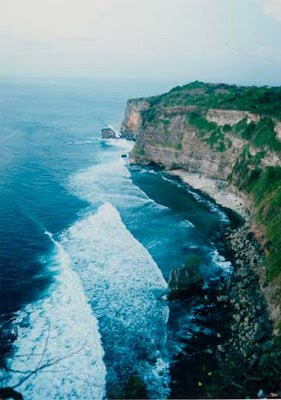In the South Indian Ocean, straddling the equator just south of the Philippines, and stretching from mainland Asia all the way to Papua New Guinea, there lies a vast archipelago of perhaps eighteen-thousand islands. Violent volcanic activity has encouraged these mountains to rise above the sea and provide niches for ecosystems diverging from dry and arid savannas to lush and tropical rain forest. Immense volcanic peaks preside over sapphire coral reefs and jagged coastal valleys where local populations are isolated even from their neighbors on the same island. Niches like these have preserved an ethnic diversity that accounts for over 700 distinct and living languages.
When the hominid Java man walked here 700,000 years ago he may have faced competition from other nomadic proto humans during an age before Java, Sumatra and Borneo broke away from the Asian continent and drifted into the sea. These early human inhabitants must have conducted experiments with the local vegetation; they probably ate everything in sight. Eventually they developed lore for incorporating indigenous seeds, grasses, leaves and roots into their foods. By the first millennium BC they were cultivating rice and domesticating animals.
The ensuing history of the archipelago is a story of continuous seasonings from the most advanced cultures of the day. The great seafaring powers that plied the seas between China and the Middle East found the archipelago smack in the middle of their trade routes. Not only was this a convenient port of call, but nature had granted these islands an exclusive concession in spices that were worth their weight in gold. As trade increased, foreigners came in ever-greater numbers and introduced strange religions and philosophies. Some of their practices involved novel ingredients and cooking techniques that were eventually adopted and transformed into something uniquely Indonesian.
By the Han Dynasty (206 BC - 220 AD), Chinese merchants were jabbering about soybeans and demonstrating how to cook noodles and tofu in a wok. Nowadays Mie Goreng (friend noodles) cooked in wajan (wok) is one of the most common of Indonesian street foods, and tahu (tofu) is found in just about every warung. The locals also figured out how to maximize the protein potential of the soybean by mixing it with an obscure mold they found growing on hibiscus leaves. The result was the tempe that is appreciated today by vegetarians worldwide.
Around the same, but from the opposite direction, Indian traders arrived. They must have had more missionary zeal than Chinese counterparts, because their model of Hindu city state took hold Sumatra and Java, and empires began to spread far and wide. The Indian pantheon of Gods and Goddesses was graciously invited to steep for a while in the native animism, and to morph with an adapted flavor of Buddhism. In another cauldron, wondrous curries were embraced and enchanced to contain coconut milk and local spices. Stowaways on board ships from India included coriander, cumin, cucumbers, mangos, eggplants, and onions.
Not long after Islam swept through the Middle East, it began to take hold in the Islands, especially in the port cities. Missionaries accompanying Arab merchants advocated Islam as a casteless system with salvation for all. After curing for a time in local Hindu-Buddhist animism, a unique hybrid of Islam took hold that has endured to the present day to find Indonesia the largest Moslem country in the World. During those early days, the mutton kebab was also pondered and eventually embellished to include a marinade of sweet and sour tamarind, and a topping of spicy peanuts sauce.
Anxious to profit directly from the spice trade, Europeans managed to find their way to the region late in the fifteenth century. After getting lost for a spell in the new world, Portuguese and Spanish ships arrived first. While in the Americas, they "discovered" tomatoes, corn, peanuts, not-to-mention the transformation Eucharist, the chili pepper. Apparently unaware of what they were instigating, they blithely handed the little capsicums, over to the locals.
Dutch and English ships arrived next with superior naval power. The Dutch East India Company focused on the archipelago and the initial profits where enormous. However by 1799 woeful mismanagement lead to their bankruptcy. Not willing to give up such a bountiful string of pearls, the government of the Netherlands pointed up and transformed the entire archipelago into a vast colonial plantation. The locals were treated to the arrogance and hegemony that was fashionable at the time, but they did manage to pass some of this difficult period teasing intoxicating flavors from the carrots, cabbage, and cauliflower brought from Europe. They also corrupted European pastries into a mystical cult of sweet kue.
The Republic of Indonesia won its independence in 1949 and today the culinary horizon have been brighter. Competition from American fast food joints has lead to some interesting street food hamburgers and KFC clones, but thankfully traditional Indonesian dishes are still in hot demand and readily available on every street corner. Regional diversity is overwhelming with dishes that change names and ingredients every 50 kilometers or so. Although you would need several lifetimes to sample them all, the sidewalk to encounter on of the world's greatest, albeit little-known cuisines.



